Artist José MarÍa Sicilia at Lenox Hill Neighborhood House, offers art as a mirror and a door to the past for Alzheimer patients.
The Ghost, The Mirror and Narcissus
* * *
Visiting José María Sicilia at the Lenox Hill Neighborhood House
by Zach Seeger
In a coffee shop on Lexington Ave. I bought myself some time, listening to two women youthfully plot out their lives: summers in the Hamptons, Miami in winter, friends in Milan, a week or two here, a season there. All this exuberant chatter while sentimental 90s’ pop saccharined the air with TLC, Mya, and Sugar Ray. The music was youth frozen and bottled, sad and nostalgic to those that experienced it, casual antiquated pop filler for those milling about drinking their tea and coffee maybe with a muffin. I began to think about the affect of time on the mind as I walked to Lenox Hill Neighborhood House to interview the artist José María Sicilia, and meet the CARE program director Elizabeth Hartowicz.
The main lobby of the building was being restructured with new sheet rock and tasteful drawings by clients carefully arranged. The woman behind the desk took notice of me when a phone call chimed in with someone who was unable to reach her missing elderly father. “Had he turned up there?” The woman behind the desk fielded the crises, employing an elegant exchange of empathetic sleuthing, and resolved the panic for the time being. I was reminded of my mother working in child services, “Son, we cannot solve all the problems. The attentiveness and care we provide is here so that certain people do not slip further into desperate circumstances.”
I was late and found that I was in the wrong building. I hustled to meet Elizabeth. Upon entering the nearby building I was greeted with a hug and a joyful smile. Elizabeth Hartowicz is the effervescent director of the CARE program at Lenox Hill Neighborhood House. She immediately explained the program, which offers a unique opportunity for social contact and stimulation to those individuals who, due to their progressing dementia would often be isolated in the community, while providing respite for their caregivers. The program focuses on the individual person, not on the disease. A person’s preferences, interests, and needs are the basis for the programming. Openness, flexibility, improvisation, and spontaneity are encouraged rather than a reality orientation that is often used to bring back people with dementia.
Caregivers at Lenox Hill Neighborhood House connect with clients by travelling to their realities: their space and time. Space and time: art is one of the few opportunities for them to take control and make choices. José María Sicilia, Spanish artist, and most recent visitor to the Lenox Hill Neighborhood House artist program, stood contemplatively in the room where he was set to address the clients, family members, and staff. Painter of seductive surfaces, swirling and breathless, Sicilia’s work is beautifully executed and lends itself to the performative: a trait influenced by Ab Ex and time spent with John Cage.
I expected no less than a baroque flourish of engagement with the audience, but was captivated by the sincerity and calm that followed. Without acknowledging my presence as interloper/interviewer, he treated me as visual ally on the journey: comrade Newman, shipmate Pollock, Cage, oracle on high water. He stood in the front of the room back-dropped by an HD TV displaying images of an exhibition space. He was leafing through drawings made by the participating clients.
I stood by his side and recorded his voice. He began by talking about the importance of the ghost, the print. “The ghost, for me, is myself. It’s the echo. It’s the voice of my voice. It’s the image of my image. This is the ghost: myself.” “When you were born in the body of your mother you left a lot of prints.” He continued, “The ghost is a mirror: the story of echo. She lives in the fountains. Narcissus sees himself in the fountains. In mythology, this is the first idea of the ghost. The print is in the water, in the mirror. We are the ghost of the ghost; a reflection of the reflection in the mirror.” He pulled out W H Auden’s Limbo Culture and spoke of the primal nature of organisms, the white page, and constructed memory.
He railed against intervention, framing mechanisms, and systems of control. He was in his element. The moment was curious. He did not address the audience, but was intent on examining the drawings. His rapturous gaze fell upon the work. Bridled with critical determination, he seemed not to notice the room filled with people. They did not notice him. Or did they? He did notice them. The room held an air of collective calm and focused attentiveness. I realized that this moment represented a moment of purity, a constructed present, a ship of participants. I imagined Cage and had expected Beckett.
As we talked further, continuing to look at the drawings, clients engaged in an exercise. They were prompted by an aid who presented an image of a painting printed on letter size paper. The exercise was intended to construct a narrative derived from the image. “She’s a drunk. No self-respecting husband would put up with such behavior,” one woman declared. “I think she’s exhausted from shopping,” said another woman. A man sauntered to the front of the room to claim a chair. “Hamburger,” he said hungrily with a slight smirk. “Or, maybe a steak?” he asked. Elizabeth smiled, “That’s what you want?”
And without contest or further pleading the exchange was over. The clients were satisfied with the present. As healthy seniors from the senior center rushed by (the floor is shared with them and CARE program members), Elizabeth turned to me, “Today we serve fish. Actually it’s what brings so many out.” Both José María and Elizabeth share a vision: the most beautiful trigger of memory is the unrestricted and unguided present, the essence of being and the antithesis of durational time. The here and the now is the body in the mirror. The clients and I were grateful to have these ship captains, way-finding on the open water of memory and time, here on the Upper East Side.
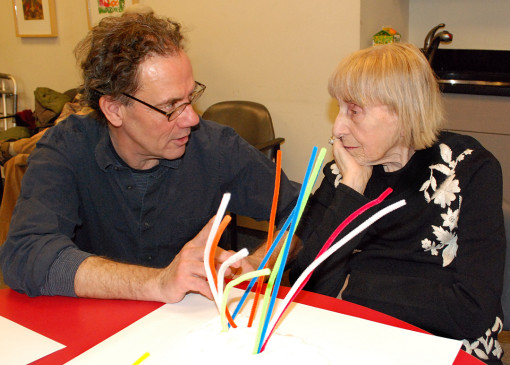
Artist José María Sicilia with a CARE program member.
CARE offers the opportunity for social contact and stimulation to those with dementia.
CARE program participant kneads clay as one of the activities in the program.
The letter dictated by an CARE resident.
The mirror used by artist José María Sicilia .
About CARE-NYC
by Elizabeth Hartowicz
CARE program is a social adult day program for the persons with dementia – mostly moderate to advance stages of Alzheimer’s disease. It’s part of the Lenox Hill Neighborhood House, which is “widely recognized as one of New York’s premier nonprofit organizations, 121-year-old settlement house that provides an extensive array of effective and integrated human services – social, educational, legal, health, housing, mental health, nutritional and fitness – which significantly improve the lives of 20.000 people in need each year, ages 3 to 103, on the east Side of Manhattan.” (website: lenoxhill.org)
The program offers a unique opportunity for social contact and stimulation to those individuals who due to their progressing dementia would often be isolated in the community, while providing some respite for their caregivers. The program is based on person-centered philosophy. It’s the person with dementia who is in the center of our interest, and not dementia. All the possible information about that person’s life, preferences, interests and needs are for us the basis for the programming ideas. That comes with openness for constant flexibility, improvisation and spontaneity, living “in the moment,” although for many, working with the stable schedule may seem easier and more comfortable.
Opposite to the “reality orientation” and all the efforts to “bring the person with dementia back” to this reality, I believe that my goal is to find the way to connect. In order to meet, I often need to travel into my members’ different realities – in space and time. Sometimes that trip requites longer duration. When a 93-years-old woman tells me she needs to hurry home because her mother is waiting for her, I could never tell her that her mother is gone. That would probably break her heart once again. Instead, I will take an imaginary trip to her “home” and ask questions, listen, try to be “in her shoes”. Often, just being there, brings comfort. And realization of time.
Losing memory is one terrible thing, but being treated like children, or worse, like not existing, can be even more painful. Because of the course of the disease, gradual degradation including the loss of ability to communicate verbally, those persons can no longer be in charge of their lives and need constant assistance in almost every move. At some point they are completely dependent on others. There is a great and often unmet need for expression and freedom.
In my role as the program director, I believe that by being true, empathetic and accepting, we can help build a human environment, which enables the creative process and possibility of a positive change. Art is one of the few opportunities for them to take control in making choices. As “helpers” we sometimes feel tempted to “improve” or set direction in our participants’ works, according to our own criteria and sense of aesthetics.
We may also feel compelled to bridge the silence and rather than embrace it and take it as an opportunity to feel and meet face to face – we look for action, forms of doing, which make us feel more safe. The frustration of not getting those persons to perform tasks is perhaps the reason we do it for them. This kind of “helping” may often have an opposite effect and hinder the engagement. By painting on that person’s watercolor paper, with an intention to help, we may sometimes take away one of the few chances for her/him to make a choice, create and try to make sense of her/his life.
José María Sicilia showed interest in each of the participants during his workshops. In the world outside we may not have time to stop, have patience and embrace silence, but on “this boat” there is no need to rush. Those who want to paint – paint. Those who don’t are encouraged to express themselves in a different way. That’s why, even signing the artwork for those persons on the face of the work (rather than on its back), José María sees as “contamination.” By that, he encourages us to respect that person’s identity and dignity – find balance between facilitation and gentle encouragement.
Example of how we worked:
When José María approached me with an idea of using mirrors for a self-portrait, I “warned” him that many of our members can feel uncomfortable seeing the image in the mirror and some may even not recognize themselves. He responded: “Don’t we all have this issue?” I realized how true that was. Each participant received a mirror and was asked to paint their face. All, with one exception, followed the instruction.
There was one 90-years-old lady, Ms. M. who refused to paint, in spite of the encouragement from staff and volunteers. She did not see the sense of her making art. José María suggested that perhaps she should draw, on the mirror, with the markers, and imagine she was doing her make-up. Her response was negative to drawing, but gave us a clear explanation why.
José María asked us not to insist in encouraging her to paint; instead, he asked me to write everything she said on her empty watercolor paper. Ms. M. opened up and shared her point of view regarding “make-up”, including her belief that looking at the mirror is a “waste of time” and that she does not need that to feel happy. She took pride in dictating her words and wouldn’t leave the session without taking that sheet of paper home. That was “it” for José María….
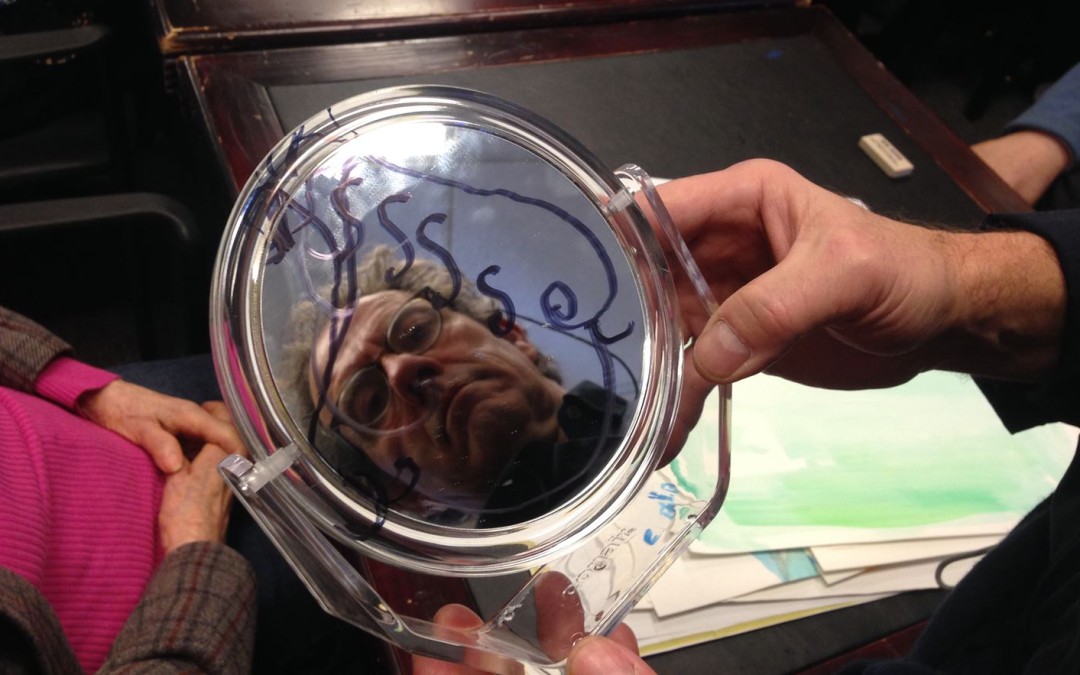
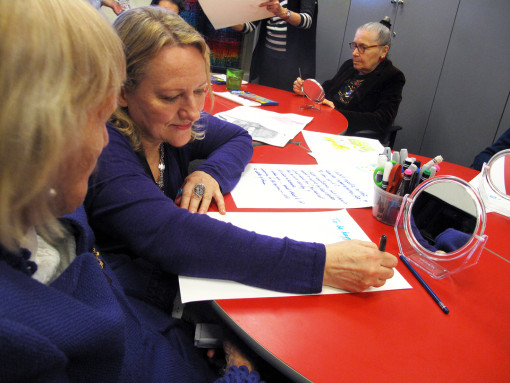
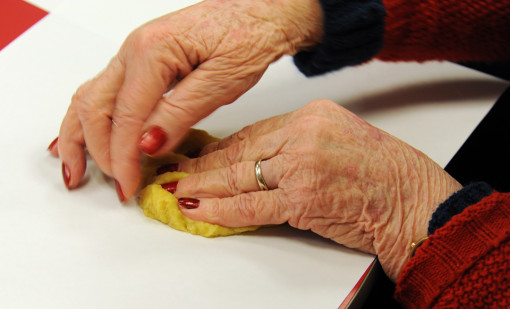
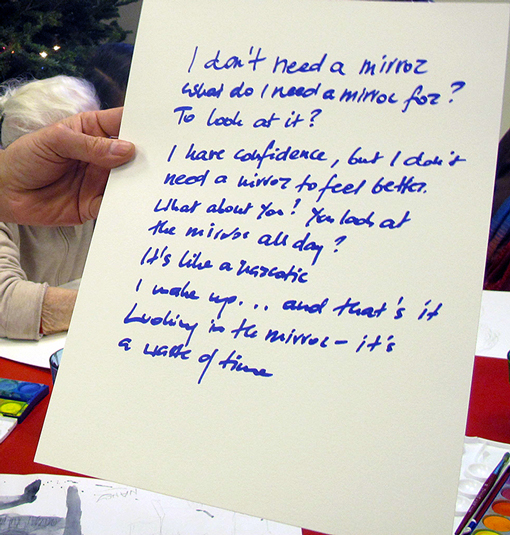
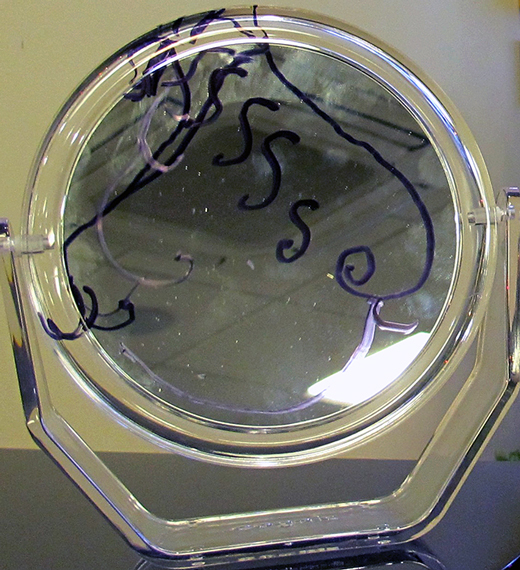


Enjoyed and program sounds wonderful.
This sounds like an extraordinary program. I was very impressed by its humanity. Kudos to Ms. Hartowicz and Mr. Sicilia, as well as to the staff of the CARE program.